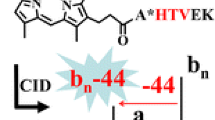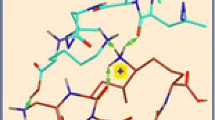Abstract:
The mechanisms of protein degradation induced by ionisation are of great interest for radiobiology, improvement of mass spectroscopy and industrial processes such as radio sterilisation. Sequences containing asparagin are very sensitive especially if surrounded by glycine. Very few techniques allow a satisfying understanding of the processes induced by creation of an anionic or cationic site in a peptide. We used the methods of quantum chemistry (DFT/B3LYP with 6-31G* basis set) to characterise the geometry modifications induced in the cations or in the anions derived from peptide Gly Asn Gly. The cationic sites are localised mostly close to the first peptidic bond and induce a lengthening of the Ca-C(O) bond. Conversely the anionic sites are localised on a carbonyl function. Implications are discussed considering the radiolytic products and the proposed mechanisms.
Similar content being viewed by others
Author information
Authors and Affiliations
Additional information
Received 21 January 2002 Published online 13 September 2002
Rights and permissions
About this article
Cite this article
Houée-Levin, C., Bergès, J. A DFT study of electron or hole localization in a peptide containing asparagin. Eur. Phys. J. D 20, 551–555 (2002). https://doi.org/10.1140/epjd/e2002-00142-y
Issue Date:
DOI: https://doi.org/10.1140/epjd/e2002-00142-y




